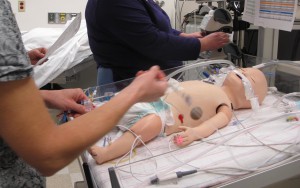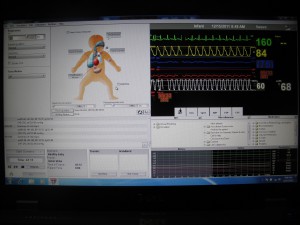
Medical simulators give doctors and nurses an opportunity to practice without risking patient harm. Peter Weinstock and his team are creating sophisticated, scenario-based simulations that bring new realism to medical training.
Things had taken a turn for the worse as the neonatal intensive care unit (NICU) team tried to stabilize the two-day-old boy just transported in from a hospital in Maine:
“His heart rate is going down.” “I think he’s going into tachycardia, have the defibrillator ready.” “Starting chest compressions!”
The care team struggled to get the baby’s heart function under control while addressing his deteriorating lung problems.
That’s when the facilitator announced: “The simulation is over, everyone. Let’s go back to the conference room and debrief.”
Everyone stepped back, and that’s when I saw that the child on the bed wasn’t a child – it was a very advanced mannequin – and that the doctors and nurses working feverishly in front of me were taking part in a training, one of hundreds run every year by the Children’s Hospital Boston Simulator Program.
The program, one of the most advanced scenario-based clinical training systems in the world, helps medical teams practice their skills in an environment where people can make mistakes without risking patient harm. “Ours is one of the few high-risk industries that doesn’t practice prior to game time,” says program director Peter Weinstock, a critical care physician at Children’s. “Medicine is late in coming to this idea.”
“It’s a lot of technology, but the program is really about people and how they make decisions at the bedside.”
Now just over a decade old, the program tries to address the practical realities of training in pediatric medicine. “When it comes to learning new techniques or training on established ones, it’s a question of opportunities,” Weinstock explains. “Kids are generally healthy, and there are few places that see a lot of children, especially those with rare conditions or who are severely ill.”
Many hospitals have medical simulators – rooms or suites in office buildings set up as generic procedure or operating rooms – but the Children’s program takes simulation to the bedside. “Most simulation programs take place offsite, in a space removed from practitioners’ normal working environment,” Weinstock observes. “We work off two models of simulation: a dedicated space embedded in one of the intensive care units, and a mobile unit that we can wheel into the same procedure or operating room a team normally works in, essentially at the point of care.”

Technicians can control the "patient" remotely, making it respond to treatments given during the simulation just as a real child would.
The level of technology is part of what makes program unique. Weinstock’s team of bioengineers has made several enhancements to commercially available, high fidelity mannequins, such as an embedded circulatory system that allows them to “bleed.” Other modifications make it possible to carry out complete procedures on “plug and play” limbs and components, which can be swapped in and out depending on the needs of a particular simulation.
Adding further realism, the mannequins are connected to a sophisticated computerized system that processes the clinical data built into the scenario being simulated, mimicking blood pressure, heart rate and other parameters. “We try to build the simulation scenarios from the records from actual cases,” Weinstock notes. “So for today’s, we drew on the case of a child that really was transported here for pulmonary hypertension.”
Weinstock also showed me footage taken of teams simulating placement of cardiac catheters or operating on severe leg fractures:
Video courtesy of the Children’s Hospital Boston Simulator Program, and displayed with permission of the participants.
Technicians can change the “patient’s” clinical stats in mid-simulation, making the mannequins respond to a team’s decisions and actions as a live patient would. The system also records audio, video and telemetry for everything that happens during the session: fodder for the debriefing that follows, where every member of the team can talk about the experience, discuss what they think they did right and wrong and come up with take-home lessons.
“It’s a lot of technology, but the program is really about people and how they make decisions at the bedside,” Weinstock notes. “Do you decide what to do based on intuition or data? We try do delve into these kinds of questions through simulation.”
The program has taken off to the point that the team has a hard time meeting the demand. “Nearly every department in the hospital is taking part,” says program manager Laura Clark.
“Our scenario was very realistic, requiring each of us to draw upon our own fund of knowledge and to work as a group to optimize the care of a very complicated patient,” says Donna Brezinski, a fellow in the Children’s NICU who was on the team taking part in the simulation I observed. “Despite the fact that we were all experienced care providers, we all learned a great deal from our participation and the debriefing afterwards. Every medical care provider should have this experience.”






